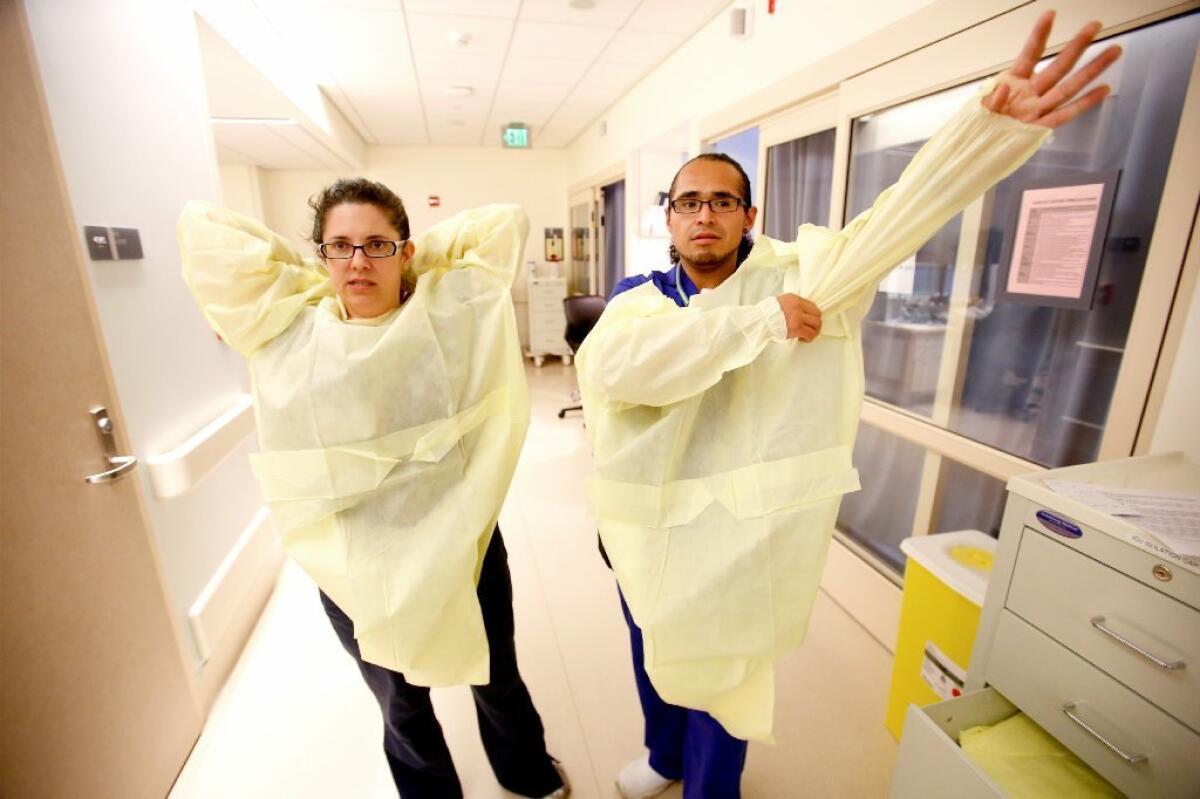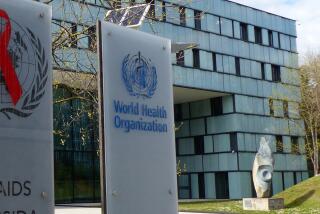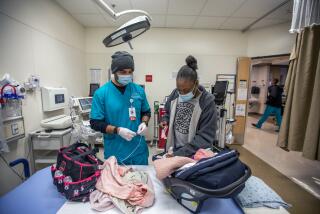Study reveals why gowns and gloves can be so dangerous for hospital workers

Nurses gown up before seeing a patient. A new study finds that hospital workers are at risk of becoming contaminated with dangerous pathogens, even when they put on and remove their gowns and gloves correctly.
- Share via
A hospital ought to be the last place to get a life-threatening infection, but it happens. A new study helps explain why.
Researchers asked real hospital workers to remove gowns and gloves smeared with fake bacteria. When they did, the fake bacteria wound up on their skin or clothes 46% of the time, according to their report published Monday in JAMA Internal Medicine.
In other words, the odds that these healthcare professionals could take off their protective coverings without contaminating themselves were only slightly better than the flip of a coin.
NEWSLETTER: Get the day’s top headlines from Times Editor Davan Maharaj >>
The hospital workers weren’t staffing the gift shop or validating parking tickets. Of 435 simulations performed in the study, 246 were done by nurses, 72 by doctors and 117 by folks like phlebotomists, physical therapists, dietitians and radiology technicians.
The researchers, led by Dr. Myreen Tomas of the Cleveland Veterans Affairs Medical Center, recruited these volunteers from four hospitals in the Cleveland area. The workers put on “contact isolation gowns” and nitrile gloves, then were given half a milliliter of a fluorescent lotion that glowed under a black light — a stand-in for invisible pathogens. They were asked to rub the lotion on their gloved hands for 15 seconds, then wipe their hands over their gowns. After that, they got a clean pair of gloves.
Next, the volunteers were asked to remove their gowns and gloves the way they normally would. When they were done, the researchers used the black light to see if any lotion was left behind.
The hospital workers got the lotion on their clothes and skin 38% of the time when they took off their gowns and 53% of the time when they took off their gloves. Overall, the average “contamination” rate was 46%.
Employees of all four hospitals were about equally likely to contaminate themselves, the researchers found. In addition, all of the different kinds of workers were about equally likely to make a mistake in putting on or taking off their personal protective equipment. The most common mistakes were failure to pull gloves over the wrist, taking gowns off over the head (instead of pulling them away from the body), putting on gloves before the gown and touching the outside of a dirty glove when taking it off.
When volunteers made a mistake, they wound up contaminated 70% of the time. But even when they followed the procedures perfectly, they still contaminated themselves 30% of the time.
Tomas’ hospital responded to these results by launching an effort to train employees on how to don and doff gowns and gloves according to the protocols recommended by the Centers for Disease Control and Prevention. Workers watched a 10-minute video, then practiced their technique for 20 minutes.
It certainly helped. The training reduced the contamination rate from 60% all the way down to 19%, according to the study. But it wasn’t perfect.
“Although contamination of skin and clothing was reduced by the intervention, it was not reduced to zero,” the study authors wrote.
The results help explain why multidrug-resistant bacteria are such a stubborn threat in hospitals. Other studies of real-world conditions have found that between 2% and 5% of hospital workers caring for colonized patients wind up with the pathogens on their hands after taking off their gloves. In one study, 24% of those treating patients with Clostridium difficile got spores on their hands.
Part of the solution is to make sure healthcare workers get better training on how to put on their gowns and gloves, and how to take them off, the study authors wrote. But training can do only so much.
Perhaps workers should disinfect their gowns and gloves before they take them off, either with bleach or possibly ultraviolet C light.
Ultimately, the best solution may be to redesign personal protective equipment so that it’s easier to remove without contaminating oneself, the study authors wrote.
That won’t happen overnight, but some improvements might be easy to make. For instance, hospitals could provide gowns in a variety of sizes instead of relying on a one-size-fits-all approach. The researchers noted that in their observations, workers who were either petite, tall or large had more trouble removing their gowns safely.
Follow me on Twitter @LATkarenkaplan and “like” Los Angeles Times Science & Health on Facebook.
Hoy: Léa esta historia en español
ALSO:
How ecotourists actually make things worse for wildlife
Cheers! For those managing diabetes, wine can help, study says
Scientists find DNA differences between gay men and their straight twin brothers







